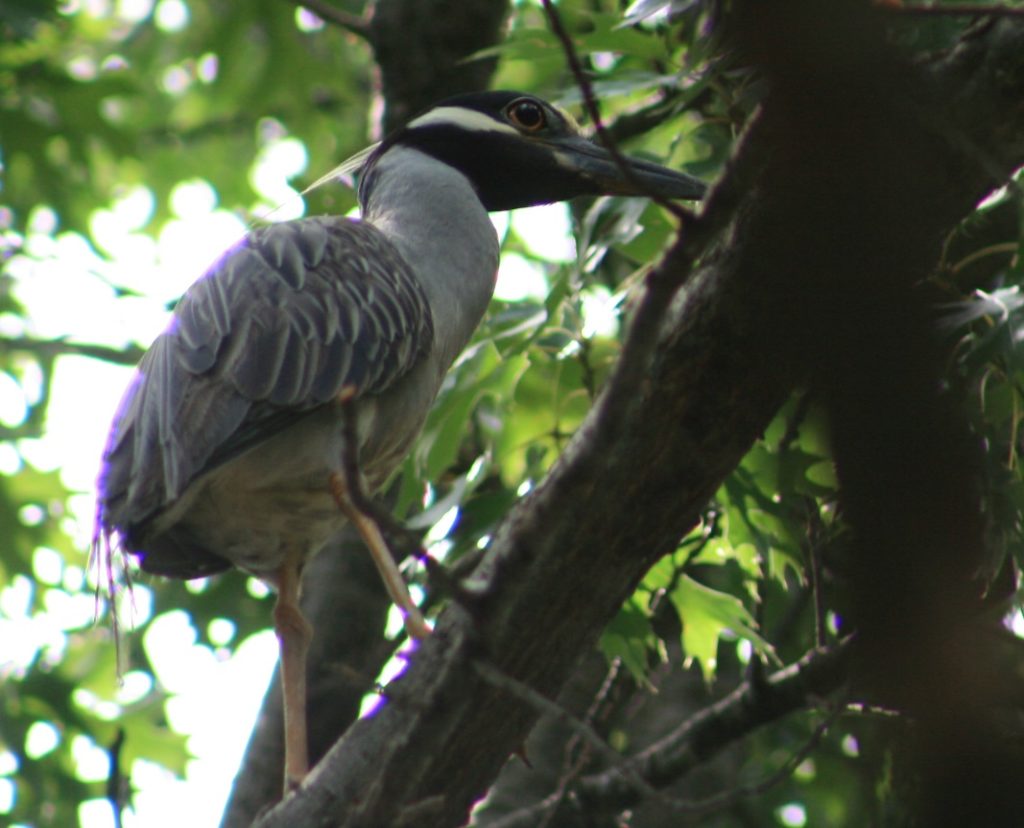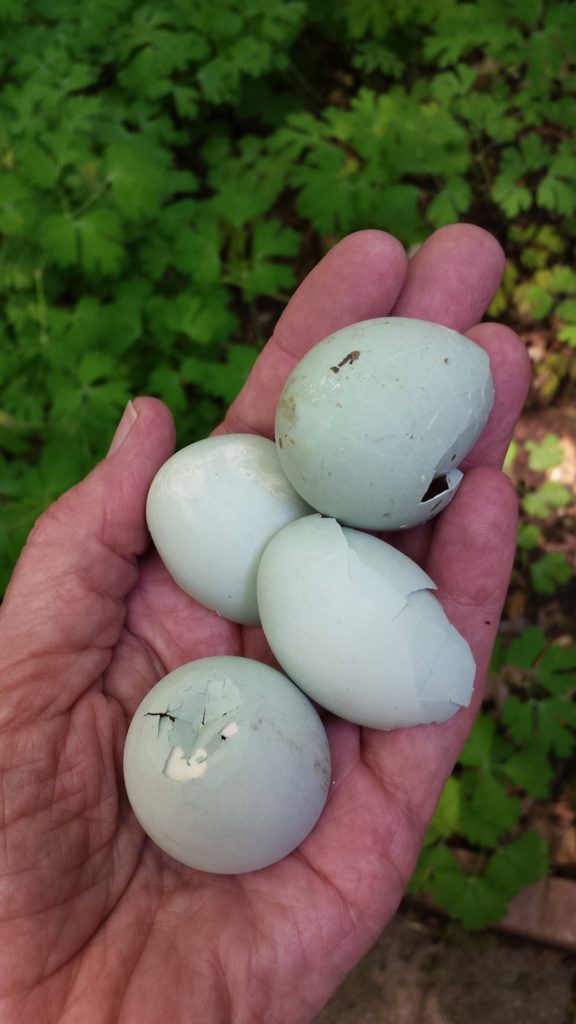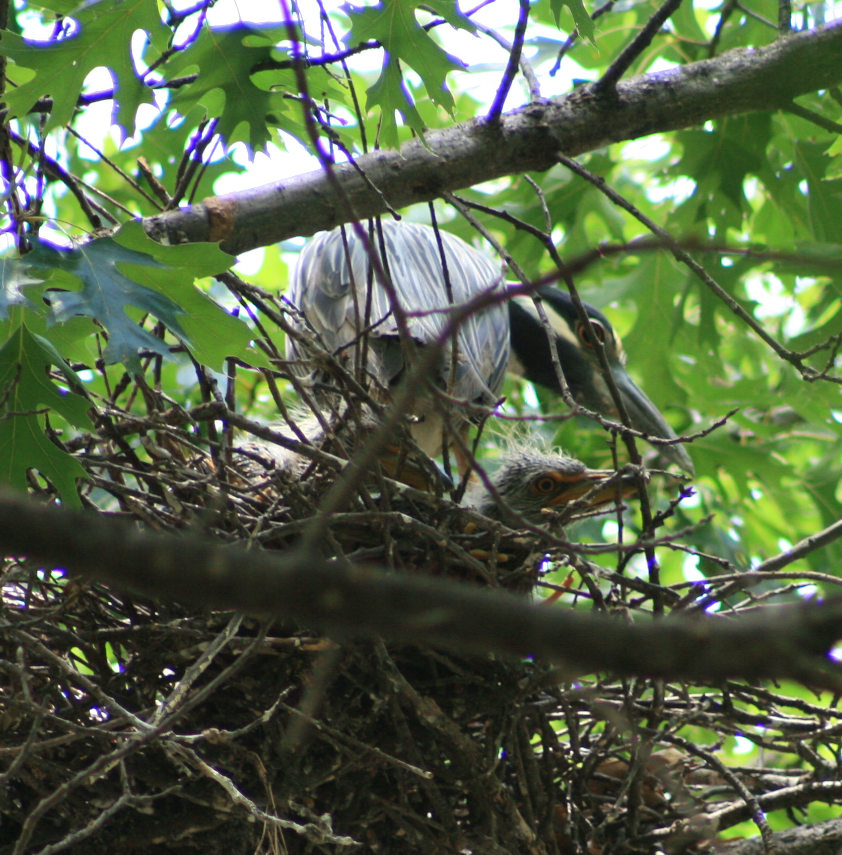INTRO
On Jun. 18, 2019, I found a rather large light blue egg shell in our back yard. I didn’t know what kind of bird it had come from, but I didn’t think there was anything that large in our back yard, so I assumed that it had blown in during a recent storm and didn’t think anything of it. But 3 days later, there was another shell in the same place as the first. This is when I had the inspiration to actually look up, and there, 32 feet above ground, was a large nest with a yellow crowned night heron sitting on a branch nearby. I found a third shell the next day and began watching the nest regularly.
I first spotted one of the fledglings on July 1, and by July 4 they had started sitting up on the side of the nest. We went out of town later that month, and the nest gradually deteriorated over the winter, so I didn’t really expect anything the next year, but they came back in 2020 and built a new nest in exactly the same place as the previous year. What follows is a time line of my observations from 2020, along with some other information about this species from various sources.

HERONS
Herons belong to the family, Ardeidae, along with egrets and bitterns. This family consists of 63 species worldwide, and cover the globe outside of the polar regions. The yellow-crowned night heron (Nyctanassa violacea) ranges throughout eastern North America, as far north as southern Minnesota. While most herons’ diets consist mainly of fish, the yellow-crowned night heron feeds almost exclusively on crustaceans, which accounts for its greater population in coastal areas. In north Texas they eat mainly crayfish, which are abundant in places like Conamera and Oak Point Park, both within 3 miles of the nest site. This becomes readily apparent by examining the droppings on the ground under the nest, which contain lots of pieces of broken up carpace.
The black-crowned night heron is a closely related species that also inhabits the North Texas area. However, black-crowned night herons are almost exclusively nocturnal, and therefore less likely to be observed. (The yellow-crowned night heron is “partially” noctural.)

2020 TIMELINE
Mar. 27–first sighting of 2020. The pair of adult herons were actively engaged in building their nest. One of them stayed on the nest while the other would fly to a nearby tree (a bald cypress in this case), break off a stick from a dead branch and bring it back to the one on the nest. The one on the nest would then work the stick into the nest, and not until they were both satisfied would the first one fly off to get another stick. This whole process took 2 – 3 minutes per stick.
The Cornell website, allaboutbirds.com, states “Initially the male carries sticks to the female, who begins the nest. Later, both gather and place materials on the nest.” I did not observe any occasions of building that did not consist of one heron passing a stick to the other.
Apr. 10–They appeared to have completed the nest.
Apr. 15–First observed one heron sitting on nest for long periods of time, presumably incubating the eggs.
Apr. 30–They appeared to be working on the nest again after it had suffered some storm damage the night before.
May 2-4–Found 4 egg shells under nest.

May 18–First sighted nestlings.
May 26 & 28–Observed adults giving sticks to the nestlings. The nest also expanded somewhat during this period, which suggests that these herons learn nest-building skills while still living in the nest. This is the one behaviour that I observed that I have not been able to find referenced anywhere.
May 29-Jun. 15–During this period, the fledglings gradually moved farther from the nest to perch on other branches in the same tree during the day, usually accompanied by one of the adults.
Jun. 16-24–The nest appeared to be abandoned, but several times an adult and one or two of the offspring would show up for a feeding time. They probably return to the nest for this because, unlike other birds, yellow-crowned night herons feed their young by regurgitating into the center of the nest. When all the fledglings are feeding, it makes a clicking/buzzing sound, which abruptly stops when they finish.
This species generally only raises one brood per year because the young must be taught to hunt. Thus, the family group stays coherent even after abandoning the nest. This may account for the difference in the timing of the nests between 2019 and 2020. (First egg shell found Jun. 18 in 2019 vs. May 2 in 2020.) If they lose a brood while there is still time to raise another, they will do that. I’m guessing that they lost their entire nest earlier that year and moved to our tree instead to start over.
Herons tend to use the same nest for several years, and we hope to see them again next year.


